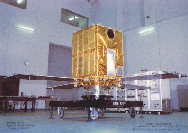|
|
|
|
The Ginga Satellite
 stro-C, renamed Ginga (Japanese for 'galaxy'), was
launched from the Kagoshima Space Center on 5 February 1987. The primary
instrument for observations was the Large Area Counter (LAC). Ginga was the
third Japanese X-ray astronomy mission, following Hakucho and Tenma. Ginga
reentered the Earth's atmosphere on 1 November 1991.
stro-C, renamed Ginga (Japanese for 'galaxy'), was
launched from the Kagoshima Space Center on 5 February 1987. The primary
instrument for observations was the Large Area Counter (LAC). Ginga was the
third Japanese X-ray astronomy mission, following Hakucho and Tenma. Ginga
reentered the Earth's atmosphere on 1 November 1991.
Mission Characteristics
 Lifetime :
February 5, 1987 - November 1, 1991 Lifetime :
February 5, 1987 - November 1, 1991
 Energy Range :
1 - 500 keV Energy Range :
1 - 500 keV
 Payload : Payload :
- Large Area Proportional Counter (LAC) 1.5-37 keV
Eff. area = 4000 cm2, FOV = 0.8° x 1.7°
- All-Sky Monitor (ASM) 1-20 keV
Eff. area = 70 cm2, FOV = 1° x 180°
- Gamma-Ray Burst Detector (GBD) 1.5-500 keV
Eff. area = 60 cm2 (SC) and 63 cm2 (PC),
FOV = All-sky
 Science Highlights:
Science Highlights:
- Discovery of transient Black Hole Candidates and study of their
spectral evolution.
- Discovery of weak transients in the galactic ridge.
- Detection of cyclotron features in 3 X-ray pulsars: 4U1538-522,
V0332+53, and Cep X-4.
- Evidence for emission and absorption Fe feature in Seyfert probing
reprocessing by cold matter.
- Discovery of intense 6-7 keV iron line emission from the galactic
center region.
 Archive :
Lightcurves, Spectra, and Raw data from the LAC experiment.
Archive :
Lightcurves, Spectra, and Raw data from the LAC experiment.
[About Ginga] (http://heasarc.gsfc.nasa.gov/docs/ginga/ginga_about.html)
[Archive] (http://heasarc.gsfc.nasa.gov/docs/ginga/archive/ginga_archive.html)
[Software] (http://heasarc.gsfc.nasa.gov/docs/ginga/software/ginga_software.html)
[Gallery] (http://heasarc.gsfc.nasa.gov/docs/ginga/ginga_images.html)
[Publications] (http://heasarc.gsfc.nasa.gov/docs/ginga/bib/ginga_biblio.html)
|
|
